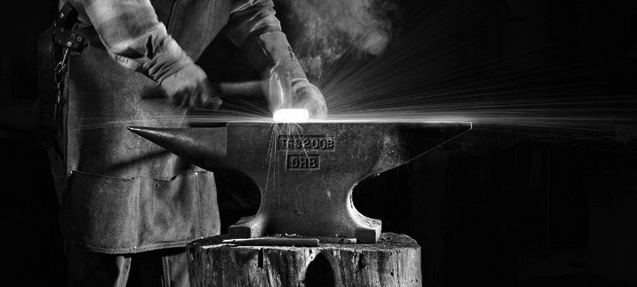In the early 20th century, the IUJH was very closely associated with the Teamsters union, which represented the professional drivers of horse drawn vehicles. The friendship the IUJH enjoyed with the Teamsters was far reaching. So much so that no Teamster would drive any horse that did not bear a IUJH logo on it’s shoe.
Horse numbers gradually declined due to farm and transportation mechanization in the years after WWI, until bottoming out in 1960. During those years, the Teamsters traded their horses for trucks and buses and grew to become one of the largest unions in America.
Though the size of the IUJH decreased considerably over the course of the twentieth century as technology changed and slowly phased out the horse as a means of transport, through the determination of its membership the organization persevered, and its membership has evolved with the changing times as well. Many of the horsehoers of yesterday have traded in their forges, anvils, and hammers for the tools of auto technicians, construction workers, and electricians. Our membership is diverse and it is growing; made up of men and women from all backgrounds who work in a wide range of trades—blue and white collar, private and public sector. But one thing remains the same: Our members are the people who keep this country working, who keep it strong, who keep it moving forward.
Like all labor unions, the IUJH was created to benefit workers. That remains its only focus today, now that the proud International Union of Journeymen Horseshoers has become the International Union of Journeymen and Allied Trades. And though IUJAT remains true to our roots, continuing to train, examine and certify new journeymen horseshoers into this challenging line of work, the IUJAT has also continually evolved with the changing times and grown in recent years. The IUJAT is has gotten an infusion of lifeblood under the direction of new officers who are revitalizing this proud union. The IUJAT now represents workers in numerous diverse industries throughout the nation. In November 2003, three national unions—USWU, UPSEU, and NOITU—affiliated with the IUJAT, bringing the our ranks to over 80,000 members.
In the 21st century, the IUJAT has not only adapted and evolved with the changing workforce and economy, and expanded into a diversity of sectors—including energy, service, construction, automotive, public sector, transportation, construction, manufacturing, and many more—we have also stayed true to our proud roots. Among our ranks are a division of the same Journeymen horseshoers who established the union in 1874, the JHU, Local 947.
With a vision for the future, dynamic leadership, and a philosophy of ultimate freedom and democracy for our affiliates, it becomes clear why the IUJAT is one of the fastest growing, most forward-thinking unions in the nation.

